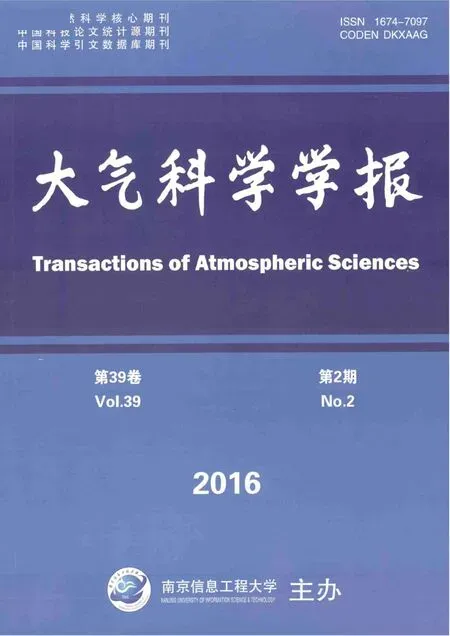热带太平洋低层环流主模态与东亚大气环流的可能联系
2016-10-27谭桂容耿新卢明
谭桂容,耿新,卢明

热带太平洋低层环流主模态与东亚大气环流的可能联系
谭桂容①②*,耿新①②,卢明③
① 南京信息工程大学 气象灾害教育部重点实验室/气象灾害预报预警与评估协同创新中心,江苏 南京 210044;
② 南京信息工程大学 大气科学学院,江苏 南京 210044;
③ 94865部队气象台,浙江 杭州 310021
2014-05-14收稿,2015-03-10接受
国家自然科学基金资助项目(41475088);公益性行业(气象)科研专项(GYHY20120616;GYHY20130628);江苏省高校自然科学研究项目(13KJB170013);江苏省青蓝工程
利用1958—2001年NCEP/NCAR再分析资料,探讨了热带太平洋(100°E~60°W,10°S~10°N)10 m风场的时空变化特征及其与东亚大气环流的可能联系。结果表明:1)热带太平洋风场异常存在两种主模态,第一模态对应中西太平洋一致的西(东)风异常,关于赤道呈准对称分布,与ENSO(El Nio-Southern Oscillation)暖(冷)位相时风场的分布对应;第二模态则关于赤道呈反对称分布,西北太平洋存在显著的反气旋(气旋)式环流,中太平洋异常西风不再位于赤道上,而是南移到了10°S左右,对应ENSO暖(冷)位相向相反位相转换时的风场分布特征。2)两模态时间系数的主振荡周期不同,与ENSO循环的位相关系也不同。研究发现,当两模态呈正(负)位相分布时,贝加尔湖南侧(South to Lake Baikal,SLB)容易发生持续的高压(低压)异常环流。3)两模态与SLB异常环流的联系途径不同。第一模态正位相对应热带中东太平洋大范围暖海温引起的二极型Walker环流异常,SLB异常高压不仅能通过东亚沿岸北风和南海低槽的作用促进第一模态的前期发展,还对其后期维持起重要作用。负位相时,情况相反。该环流系统既与热带中东太平洋大范围垂直运动有关,还与邻近的中国东南沿海低层异常辐合有关;第二模态则对应热带西太平洋及东印度洋为主、大西洋为辅的暖海温引起的热带四极型Walker环流异常。此时热带西太平洋到东印度洋局地偏强的经圈Hadley环流可能是SLB异常环流维持的主要原因。
热带环流异常大气环流异常海气相互作用贝加尔湖南侧经验正交函数
热带海洋大气系统在维持全球海洋和大气环流中发挥重要作用。作为全球海气相互作用最为剧烈的地区,热带太平洋海气系统及其与中纬度大气环流相互作用的研究是大气科学的重要课题。
由于赤道附近准地转关系不成立,实际分析中热带地区更多采用风场来表征大气环流(李崇银,1984)。热带太平洋低层风场的作用至关重要,既可用其估计大气对海洋的动力作用(吹流作用),又可借助其变化了解大气对海洋热力(感热、潜热)作用的响应(王盘兴等,1991)。Walker(1928)很早就指出热带风场与海表温度存在密切联系,随后Bjeknes(1972)给出了描述热带海气系统异常的El Nio-Southern Oscillation(简称ENSO)现象的概念,Wyrtki(1975)首次强调了赤道信风异常在ENSO循环中的作用。此后的研究进一步指出热带西太平洋西风异常出现在中东太平洋海温增暖之前,且该风场异常的东传与ENSO发生发展存在某种内在的动力学联系(Rasmusson and Carpenter,1982;傅云飞和黄荣辉,1996;张人禾和黄荣辉,1998;严邦良和张人禾,2002;曾刚等,2015)。研究表明,这种西风异常的产生,可能与El Nio上一年冬季东亚频繁的寒潮活动有关(Li,1990;普业等,2006),也可能是南北半球大气相互作用的结果(阮均石,1998)。Zheng et al.(2014)通过对观测资料和数值试验的综合研究发现,热带西太平洋西风爆发与东亚冬季风和澳大利亚夏季风一致偏强有密切联系,东亚冬季风异常可能是后期ENSO发生发展的重要原因之一。
ENSO发生以后,异常信号最先反映到热带低层大气环流场上,然后再通过大气遥相关影响热带外地区。El Nio事件能够在热带大气强迫出有利于热带西太平洋和我国南海地区出现反气旋性环流异常的热力结构,再通过准定常行星波的传播导致东亚中高纬地区发生环流异常(Zhang et al.,1996;Wang et al.,2000),且不同阶段的ENSO事件对应的热带环流异常不同,对东亚大气环流的影响也不同(Huang and Wu,1989;倪东鸿和孙照渤,2000;金祖辉和陶诗言,1999;何溪澄等,2008)。近期研究发现热带太平洋低层风场第二模态是海温年循环与ENSO非线性相互作用产生的组合模态(Stuecker et al.,2013),其不仅能导致强El Nio事件迅速衰减(Mcgregor et al.,2012,2013),还是形成西北太平洋反气旋,即ENSO影响东亚大气环流和天气气候的关键(Zhang et al.,2015)。热带大气环流的中间调整也是ENSO影响东亚天气气候的必经之路。也就是说,在ENSO与热带外东亚季风环流的相互作用过程中,热带大气环流的调整发挥着很关键的中间桥梁作用。
基于热带风场在ENSO与东亚季风的年际相互作用过程中的纽带作用,本文拟从热带太平洋月平均低层环流异常主模态及其变异角度分析其与东亚大气环流的关系,进一步探讨热带太平洋海气系统的时空变化特征及其与东亚大气环流的可能联系。
1 资料和方法
1.1资料
1)美国国家环境预测中心/国家大气环境中心(NCEP/NCAR)整理的1958—2001年全球再分析月平均风场和位势高度场资料,分辨率为2.5°×2.5°;
2)美国国家海洋和大气管理局(NOAA)重建的1958—2001年全球月平均海陆降水距平资料(PREC),分辨率为2.5°×2.5°;
3)NOAA拓展重构的1958—2001年全球月平均海表温度资料,分辨率为2°×2°;
以下均为对去除季节变化之后的距平资料进行分析。
1.2方法
主要采用组合变量经验正交函数(MutiVariate EOF,MV-EOF)分解、线性相关、线性回归、Morlet小波等分析方法,在此对组合变量经验正交函数(MV-EOF)分解方法作简要介绍:若资料有m个空间点,n个时间点,根据风场的MV-EOF分析方法(王盘兴,1981),首先将所有格点上U、V合并起来,组成资料矩阵2mXn,2mXn中前m行是n个时间点上m个格点的东西风,后m行对应南北风;然后按经典标量场EOF方法,计算出特征向量和对应的时间权重系数。每个特征向量都是一个2m维的列向量,前m个元素对应m个空间点上东西风U,后m个元素对应m个空间点上南北风V;然后将其叠加在一起,得出m个空间点上向量风场,组成风场的特征向量场,对应的每个时间权重系数都是一个长度为n的时间序列。
2 热带太平洋低层环流主模态
为揭示低层环流的时空变化特征,对热带太平洋(100°E~60°W,10°S~10°N)10 m逐月水平风场进行MV-EOF分解,空间型用对应的标准化时间系数与原距平场的回归系数表示,根据North et al.(1982)的EOF显著性检验法则,前2个模态均能通过显著性检验,其累积方差贡献率占34.4%。从第三模态开始方差贡献率小于10%,这里不作讨论。

图1 热带太平洋10 m距平风场MV-EOF得到的第一(a)、第二(b)模态时间系数回归的原场分布(单位:m·s-1)Fig.1 Regression coefficients between time coefficients of the (a)first and (b)second MV-EOF modes and the 10 m monthly wind anomalies over the tropical Pacific(units:m·s-1)
第一模态(图1a)的方差贡献为20.0%,反映了热带太平洋低层10 m风场最主要的变化特征。对应的空间型关于赤道呈准对称分布,热带中西太平洋存在一致的纬向风异常,当时间系数为正(负),即第一模态呈正(负)位相时,除140°E以西有弱东(西)风之外,热带中西太平洋主要由西(东)风异常气流控制,最大西(东)风位于赤道附近,这也与Stuecker et al.(2013)得出的第一模态分布类似。对应的标准化时间系数(简称PC1)与同期Nio3.4指数之间的相关系数达0.74,通过了信度为0.01的显著性检验,表明第一模态是ENSO暖(冷)事件对应的模态。

图2 热带太平洋10 m距平风场前两个MV-EOF模态对应的时间系数Fig.2 Time coefficients of the two leading modes of the 10 m monthly wind anomalies over the tropical Pacific
第二模态(图1b)占总方差的14.4%,空间型关于赤道呈反对称分布,当时间系数为正(负),即第二模态呈正(负)位相时,热带中太平洋的最大西风异常不再位于赤道上,而是南移到了10°S左右,西北太平洋对应一显著的反气旋(气旋)式环流。虽然标准化的第二时间系数(简称PC2)与同期的Nio3.4指数之间没有显著的相关关系,但其在ENSO循环过程中仍扮演重要角色。El Nio成熟后西北太平洋常出现反气旋异常(Zhang et al.,1996),使得赤道西太平洋产生东风距平,进而导致El Nio向La Nia的转换(张人禾和黄荣辉,1998)。事实上,这一模态是西太平洋海温年循环与ENSO非线性相互作用的产物(Stuecker et al.,2013),其对应的跨赤道纬向风强经向切变及西风异常的南移与强El Nio事件的衰减密切相关(Mcgregor et al.,2012,2013)。

图3 MV-EOF分解得到的标准化时间系数的Morlet小波分析(虚线为边界影响区域;阴影表示通过了信度0.05的显著性检验) a.PC1;b.PC2Fig.3 Morlet wavelet power spectrum of the normalized time series derived from MV-EOF analyses(the affected boundary zone is shown by dashed lines;shading indicates statistical significance at the>95% confidence level):(a)PC1;(b)PC2
两模态时间系数(图2)存在明显的季节和年际变化特征。从PC1、PC2的逐年—逐月剖面(图略)中不难看出,第一模态(即中西太平洋一致的西风异常)常在下半年达到正位相峰值,这与ENSO一般在春夏季发展,秋冬季成熟是吻合的。比较而言,PC2一般在PC1最大值的1~2个月后达到峰值,这是因为PC2一般与强El Nio的衰减及其向La Nia的转换相联系(Stuecker et al.,2013)。由小波分析(图3),第一模态存在显著的2~7 a(约24~84个月)振荡周期,与ENSO主周期一致,且在1985年后表现的更加明显。第二模态(图3b)的显著周期信号主要位于1~3 a(约10~36个月),具体在20世纪70年代存在2 a(24个月)左右的显著周期,80年代则为1 a(12个月)左右,90年代中后期对应3 a(36个月)左右。

图4 PC1与500 hPa高度距平时滞的回归系数(等值线;单位:gpm)分布(阴影区域表示通过了0.05信度的显著性检验;每幅图上方数字的绝对值代表超前/滞后PC1的月份数,负数表示超前,正数为滞后)Fig.4 Spatial distribution of the lead-lag regression coefficients(contours;units:gpm) between PC1 and 500 hPa height anomalies(shading indicates statistical significance at the>95% confidence level;the absolute values of negative/positive numbers above each panel indicate the number of months leading/lagging PC1)
3 热带太平洋环流主模态与东亚大气环流的可能联系

图5 PC1与850 hPa风场时滞的回归系数矢量分布(箭头,对应相关矢量大小小于0.1的格点未画;单位:m·s-1;阴影表示对应相关矢量大小达到0.1的区域;每小幅图上方的数字的绝对值代表超前/滞后PC1的月份,负值表示超前,正数为滞后)Fig.5 Spatial distribution of the lead-lag regression coefficient vectors between PC1 and 850 hPa wind anomalies(arrows,grids whose magnitudes of corresponding correlation coefficient vectors are less than 0.1 are not provided;units:m·s-1;shading indicates statistical significance of the magnitude of the corresponding correlation coefficient vectors at the>0.1 confidence level;the absolute values of negative/positive numbers above each panel indicate the number of months leading/lagging PC1)
为进一步分析热带太平洋10 m风场异常与东亚大气环流的关系,分别计算了PC1、PC2与500 hPa高度场和850 hPa风场的时滞回归系数。由图4可见,第一模态正位相同期,在500 hPa高度场上,贝加尔湖南侧(South to Lake Baikal,SBL)存在回归系数的大值中心,通过了信度为0.01的显著性检验。在PC1滞后与超前的4个月内,也存在与同期类似的分布特征,高压中心强度前期略大于后期。从850 hPa风场(图5)上可见,SLB存在一显著的反气旋式环流,与此相关的北风异常到达南中国海后转向成西北风并在菲律宾附近与赤道西太平洋西风异常汇合,随着澳大利亚东海岸的异常东南风逐渐增强并控制热带西太平洋,菲律宾附近的西北风也逐渐转变为西南风。值得注意的是,在这一过程中SLB的反气旋环流中心始终存在,负位相时,情况相反。由第2节的分析可知,第一模态是ENSO模态,因此SLB异常环流不仅影响了ENSO前期的发展过程,也对ENSO后期的维持具有重要的作用。根据前人的研究,在偏强澳大利亚夏季风的配合下,偏强的东亚冬季风能显著加强赤道西太平洋的西风异常,进而激发El Nio事件(Li et al.,1990;Zheng et al.,2014),而偏强的东亚冬季风与欧亚中高纬,尤其是环贝加尔湖地区冷高压的加强有关(谭桂容和王腾飞,2014),这与本文中PC1与东亚大气环流的关系也是基本对应的。
由图6可见,第二模态正位相时,在500 hPa高度场上,SLB也存在回归系数的大值中心,且通过了信度为0.01的显著性检验。在PC2超前与滞后的4个月内,也存在类似的分布。850 hPa风场上(图7)与图6基本对应,均存在显著的反气旋式环流,PC2滞后1个月时热带东印度洋出现西风距平,加上逐渐增强的西太平洋副热带高压南部的东风距平,使Hadley环流在南亚地区的上升支愈发强劲,这可能是SLB反气旋得以维持的重要原因。由第2节的分析可知,第二模态是ENSO循环中的转换模态,其最强正位相前期往往对应强El Nio事件,而根据第一模态对应的关系,El Nio成熟后SLB仍存在高压异常,所以PC2前期SLB也存在高压异常环流,后期SLB高压异常则可能与热带东印度洋到西太平洋一带异常的Hadley环流上升支有关,负位相时,情况相反。王妍等(2014)研究指出,前期冬季印度尼西亚到西太平洋地区对流是夏季SLB环流异常的重要前兆信号之一,在一定程度上也佐证了本文的研究结论。

图6 PC2与500 hPa高度距平时滞的回归系数(等值线;单位:gpm)分布(阴影区域表示通过了0.05信度的显著性检验;每幅图上方数字的绝对值代表超前/滞后PC2的月份数,负数表示超前,正数为滞后)Fig.6 Spatial distribution of the lead-lag regression coefficients(contours;units:gpm) between PC2 and 500 hPa height anomalies (shading indicates statistical significance at the>95% confidence level;the absolute values of negative/positive numbers above each panel indicate the number of months leading/lagging PC2)

图7 PC2与850 hPa风场时滞的回归系数矢量分布(箭头,对应相关矢量大小小于0.1的格点未画;单位:m·s-1;阴影表示对应相关矢量大小达到0.1的区域;每小幅图上方的数字的绝对值代表超前/滞后PC2的月份,负值表示超前,正数为滞后)Fig.7 Spatial distribution of the lead-lag regression coefficient vectors between PC2 and 850 hPa wind anomalies(arrows,grids whose magnitudes of corresponding correlation coefficient vectors are less than 0.1 are not provided;units:m·s-1;shading indicates statistical significance of the magnitude of the corresponding correlation coefficient vectors at the>0.1 confidence level;the absolute values of negative/positive numbers above each panel indicate the number of months leading/lagging PC2)
由PC1、PC2回归的东亚500 hPa位势高度距平方差占总方差的比率(图略)可见,两模态在SLB都具有最大中心,两者共同解释的方差贡献比超过13%,这进一步表明热带太平洋环流异常与SLB高压异常存在紧密的联系。
4 热带太平洋环流主模态与东亚大气环流的可能联系途径
为了解这种相互作用的可能机理,分别计算了PC1、PC2与850 hPa及200 hPa(图略)速度势和辐散风的时滞回归系数。在与第一模态相联系的低层速度势及辐散风场(图8)上,东半球为异常的下沉运动,西半球为异常的上升运动,异常Walker环流呈现二极型。而在东半球的下沉区内,低层850 hPa上还存在相对的辐合辐散异常中心。如在中国东南沿海的海陆边界处有辐合异常,在贝加尔湖附近存在辐散异常。可见SLB反气旋既与热带太平洋异常引起的半球范围的下沉运动有关,又与邻近海陆边界区域的局地辐合环流有关。第二模态则存在从二极向四极型的转换(图9),其前期类似第一模态。从PC2滞后2个月开始,分别在热带东印度洋到西太平洋、热带东太平洋到大西洋区域出现低层辐合高层辐散的异常上升区,而在北非和中东太平洋上为相反的环流异常,异常Walker环流呈四极型,此时SLB低层为异常辐散中心,表现为与其南侧热带太平洋到东印度洋地区的上升气流相联系。

图8 PC1与850 hPa速度势(等值线;单位:106 m2·s-1)和辐散风(矢量,只画通过显著性检验的区域;单位:m·s-1)的时滞回归分布(阴影区域表示通过了0.05信度的显著性检验;每幅图上方数字的绝对值代表超前/滞后PC1的月份数,负数表示超前,正数为滞后)Fig.8 Spatial distribution of the lead-lag regression coefficients between PC1 and 850 hPa velocity potential(contours;units:106 m2·s-1) and divergent wind (arrows,units:m·s-1;only grids that are statistically significance at the>95% confidence level are provided;shading indicates statistical significance for velocity potential at the>95% confidence level;the absolute values of negative/positive numbers above each panel indicate the number of months leading/lagging PC1)
海温与降水场也表现出对应的特征(图10),第一模态在中东太平洋有大范围的暖海温和正降水异常,与该地区异常的上升运动对应;而西太平洋为显著的负海温和负降水距平,印度洋虽有暖海温异常但降水为负距平,与图8中异常的下沉运动区对应。与第二模态相关的暖海温和正降水距平主要位于西太平洋及东印度洋,此外在大西洋也存在明显的暖海温异常,分别与热带西太平洋到东印度洋、热带东太平洋到大西洋的上升异常区对应;冷海温和负降水异常主要位于中太平洋,与图9中中东太平洋异常的下沉区对应。

图9 PC2与850 hPa速度势(等值线;单位:106 m2·s-1)和辐散风(矢量,只画通过显著性检验的区域;单位:m·s-1)的时滞回归分布(阴影区域表示通过了0.05信度的显著性检验;每幅图上方数字的绝对值代表超前/滞后PC2的月份数,负数表示超前,正数为滞后)Fig.9 Spatial distribution of the lead-lag regression coefficients between PC2 and 850 hPa velocity potential(contours;units:106 m2·s-1) and divergent wind(arrows,only grids that are statistically significant at the>95% confidence level are provided;units:m·s-1;shading indicates statistical significance for velocity potential at the>95% confidence level;the absolute values of negative/positive numbers above each panel indicate the number of months leading/lagging PC2)

图10 时间系数与同期热带海温距平(单位:℃)、降水距平(单位:mm)和10 m风场距平(单位:m·s-1)的回归系数分布(阴影表示海温距平回归系数绝对值大于等于0.1;箭头表示风场距平回归矢量的大小大于等于0.1;等值线表示降水距平回归系数绝对值达到0.3) a.PC1;b.PC2Fig.10 Spatial distribution of the contemporary regression coefficients between the time series and the tropical SST anomaly(units:℃),10 m wind anomalies(units:m·s-1) and precipitation anomalies(units:mm)(shading indicates absolute values of SST regression coefficients not less than 0.1;arrows indicate magnitudes of the wind regression coefficient vectors not less than 0.1;contours indicate absolute values of precipitation regression coefficients not less than 0.3) a.PC1;b.PC2
根据以上分析,绘制了热带太平洋低层环流与东亚大气环流可能联系的示意图(图11)。第一模态对应热带中东太平洋大范围暖异常引起的二极型Walker环流异常,在东亚为异常的下沉区,SLB低层为异常的辐散中心,同时其邻近的中国东南沿海低层还存在异常的辐合中心。即SLB高压不仅与热带中东太平洋大范围垂直运动有关,还与邻近的中国东南沿海低层的异常辐合相关。第二模态则对应热带西太平洋及印度洋为主、大西洋为辅的异常暖海温引起的热带四极型Walker环流异常,此时西太平洋局地偏强的经圈Hadley环流可能是SLB低层异常辐散环流维持的主要原因,即第二模态SLB异常高压的异常维持可能与热带海洋强迫的西太平洋局地偏强的经圈Hadley环流有关。这在一定程度上也反映了前人(谭桂容等,2008)的研究成果,即北太平洋西部海温强迫的辐合辐散是导致贝加尔湖南侧环流异常的重要原因之一。

图11 热带太平洋低层环流主模态与SLB高压的联系示意图(H和L分别代表高压和低压;浅色阴影区为气流垂直上升区,深色阴影区为气流垂直下沉区) a.第一模态;b.第二模态Fig.11 Schematic diagram showing the physical processes involved in the relationship between the two leading modes of low-level circulation over the tropical Pacific and the SLB high(H and L denote high and low pressure anomalies,respectively;light/dark shadow indicates areas where upward/downward flow prevail) a.first leading mode;b.second leading mode
5 结论
1)MVEOF的结果表明,热带太平洋风场异常存在两种主模态,第一模态是关于赤道准对称分布的风场空间型,热带中西太平洋对应一致的西(东)风距平,与ENSO暖(冷)位相期间的风场分布对应;第二模态空间型关于赤道反对称,在西北太平洋存在显著的反气旋(气旋)式环流,且中太平洋西风不再位于赤道上,而是南移到了10°S左右,对应ENSO暖(冷)位相向相反位相转换时风场的分布特征。
2)第一、第二模态时间系数分别存在2~7 a(约24~84个月)和1~3 a(约10~36个月)的振荡周期。其中第一模态周期与ENSO主导周期一致。
3)当两模态呈正(负)位相分布时,贝加尔湖南侧(SLB)都容易发生持续的高压(低压)异常环流。进一步分析表明,两模态与贝加尔湖南侧高压的联系途径不同。第一模态正位相对应热带中东太平洋大范围暖异常引起的二极型Walker环流异常。SLB异常高压不仅与热带中东太平洋大范围垂直运动有关,还与邻近的中国东南沿海低层的异常辐合相关,负位相时,情况相反;第二模态正位相则对应热带西太平洋及印度洋为主、大西洋为辅的异常暖海温引起的热带四极型Walker环流异常。此时西太平洋到印度洋局地偏强的经圈Hadley环流可能是SLB低层异常辐散环流维持的主要原因,负位相时,情况相反。
上述分析反映热带太平洋低层大气与东亚环流有较好的关系。两模态都对应东亚SLB环流异常,但热带海气相互作用的特征及其联系的途径不同,这也证实了热带太平洋海气相互作用与热带外环流相互作用的复杂性。此外,本文仅从热带外源引起的直接强迫异常方面分析了其与东亚环流的联系及其可能途径,关于热带热源激发的罗斯贝波及其传播等与热带外环流的联系及机理,还需要进一步的探讨。
References)
Bjerknes J.1972.Large-scale atmospheric response to the 1964—65 Pacific equatorial warming[J].J Phys Oceanogr,2(3):212-217.
傅云飞,黄荣辉.1996.热带太平洋西风异常对ENSO事件发生的作用[J].大气科学,20(6):641-654.Fu Y F,Huang R H.1996.The effect of the westerly anomalies over the tropical Pacific on the occurrence of ENSO events[J].Chinese J Atmos Sci,20(6):641-654.(in Chinese).
何溪澄,丁一汇,何金海.2008.东亚冬季风对ENSO事件的响应特征[J].大气科学,32(2):335-344.He X C,Ding Y H,He J H.2008.Response characteristics of the East Asian winter monsoon to ENSO events[J].Chinese J Atmos Sci,32(2):335-344.(in Chinese).
Huang R H,Wu Y F.1989.The influence of ENSO on the summer climate change in China and its mechanism[J].Adv Atmos Sci,6(1):21-32.
金祖辉,陶诗言.1999.ENSO循环与中国东部地区夏季和冬季降水关系的研究[J].大气科学,23(6):663-672.Jin Z H,Tao S Y.1999.A study on the relationships between ENSO cycle and rainfalls during summer and winter in eastern China[J].Chinese J Atmos Sci,23(6):663-672.(in Chinese).
李崇银.1984.热带大气动力学研究[J].大气科学,8(1):106-116.Li C Y.1984.Study on dynamics of tropical atmosphere[J].Chinese J Atmos Sci,8(1):106-116.(in Chinese).
Li C Y.1990.Interaction between anomalous winter monsoon in East Asia and El Nio events[J].Adv Atmos Sci,7(1):36-46.
Mcgregor S,Timmermann A,Schneider N,et al.2012.The effect of the South Pacific convergence zone on the termination of El Nio events and the meridional asymmetry of ENSO[J].J Climate,25(3):36-49.
Mcgregor S,Ramesh N,Spence P,et al.2013.Meridional movement of wind anomalies during ENSO events and their role in event termination[J].Geophys Res Lett,40(4):749-754.
倪东鸿,孙照渤.2000.ENSO循环在夏季的不同位相对东亚夏季风的影响[J].南京气象学院学报,23(1):48-54.Ni D H,Sun Z B.2000.Influence of ENSO cycle at different phases in summer on the east Asian summer monsoon[J].J Nanjing Inst Meteor,23(1):48-54.(in Chinese).
North G R,Bell T L,Cahalan R F,et al.1982.Sampling errors in the estimation of empirical orthogonal functions[J].Mon Wea Rev,110(7):699-706.
普业,裴顺强,李崇银,等.2006.异常东亚冬季风对赤道西太平洋纬向风异常的影响[J].大气科学,30(1):69-79.Pu Y,Pei S Q,Li C Y,et al.2006.Influence of anomalous East Asian winter monsoon on zonal wind anomalies over the equatorial western Pacific[J].Chinese J Atmos Sci,30(1):69-79.(in Chinese).
Rasmusson E M,Carpenter T H.1982.Variations in tropical sea surface temperature and surface wind fields associated with the Southern Oscillation/El Nio[J].Mon Wea Rev,110(5):354-384.
Stuecker M F,Timmermann A,Jin F F,et al.2013.A combination mode of the annual cycle and the El Nio/Southern Oscillation[J].Nature Geoscience,6(7):540-544.
谭桂容,王腾飞.2014.2011/2012年冬季中国气温异常的成因及前兆信号[J].大气科学学报,37(1):65-74.Tan G R,Wang T F.2014.Causes and precursors of the winter temperature anomaly in China in 2011/2012[J].Trans Atmos Sci,37(1):65-74.(in Chinese).
谭桂容,孙照渤,林朝晖,等.2008.贝加尔湖南侧大陆高压与东亚夏季风和中国夏季气候的关系[J].气候与环境研究,13(6):791-799.Tan G R,Sun Z B,Lin C H,et al.2008.Land high over area south to Lake Baikal and its relation with East Asian summer monsoon and cl imate anomalies of China[J].Climatic Environ Res,13(6):791-799.(in Chinese).
Walker,G T.1928.World weather[J].Quart J Roy Meteor Soc,54(5):79-87.
Wang B,Wu R,Fu X.2000.Pacific-East Asian teleconnection:How does ENSO affect East Asian climate?[J].J Climate,13(9):1517-1536.
王盘兴.1981.气象向量场的自然正交展开方法及其应用[J].南京气象学院学报,4(1):37-48.Wang P X.1981.On the method of empirical orthogonal expansion in a meteorological vector field and its application[J].J Nanjing Inst Meteor,4(1):37-48.(in Chinese).
王盘兴,李俊,耿勃.1991.低纬850百帕辐散风场的年变化及其在厄尔尼诺年的异常[J].南京气象学院学报,14(3):294-299.Annal variation in the low-latitude 850 hPa divergent wind field with its anomaly in an El Nio year[J].J Nanjing Inst Meteor,14(3):294-299.(in Chinese).
王妍,谭桂容,卢明.2014.夏季贝加尔湖南侧环流异常的前兆信号[J].大气科学学报,37(6):758-766.Wang Y,Tan G R,Lu M.2014.The precursor of summertime anomalous circulation to the south of Lake Baikal[J].Trans Atmos Sci,37(6):758-766.(in Chinese).
严邦良,张人禾.2002.热带西太平洋风应力异常在ENSO循环中的作用的数值实验[J].大气科学,26(3):315-328.Yan B L,Zhang R H.2002.A numerical test of the effects of wind anomaly over the equatorial western pacific on ENSO cycle[J].Chinese J Atmos Sci,26(3):315-328.(in Chinese).
曾刚,武英娇,张顾炜,等.2015.1990年以来重庆秋季年代际干旱及其可能成因[J].大气科学学报,38(5):620-632.Zeng G,Wu Y J,Zhang G W,et al.2015.Interdecadal autumn drought in Chongqing and its possible cause since 1990[J].Trans Atmos Sci,38(5):620-632.(in Chinese).
Zhang R,Sumi A,Kimoto M.1996.Impact of El Nio on the East Asian Monsoon:A diagnostic study of the 86/87 and 91/92 events[J].J Meteor Soc Japan,74(1):49-62.
Zhang W J,Li H,Stuecker M F,et al.2015:A new understanding of El Nio’s impact over East Asia:Dominance of the ENSO combination mode[J].J Climate,doi:10.1175/JCLI-D-15-0104.1.
Zheng Y,Zhang R,Bourassa M A.2014.Impact of East Asian winter and Australian summer monsoons on the enhanced surface westerlies over the Western Tropical Pacific Ocean preceding the El Nio onset[J].J Climate,27(5):1928-1944.
Based on the methods of multivariate EOF(MVE-OF) and lead-lag correlation and regression analysis,the spatiotemporal variations of the 10 m horizontal wind over the tropical Pacific(10°S—10°N,100°E—60°W) and their associations with East Asian atmospheric circulation were investigated using the monthly global NCEP/NCAR reanalysis data for the period 1958 to 2001.
The MV-EOF results show that there are two leading modes of the 10 m horizontal wind anomalies over the tropical Pacific.The first leading mode captures the well-known wind anomaly pattern associated with El Nio(La Nia),and is also characterized by the equatorially quasi-symmetric westerly(easterly) wind anomalies over the central Pacific and convergence(divergence) onto the equator in the east.The corresponding PC time series(PC1) is highly correlated(R=0.74) with the time series of the Nio3.4 index,suggesting that PC1 captures the main ENSO mode and that the mode corresponds to the low-level horizontal wind anomalies during the warm(cold) phase of ENSO.The second leading mode,however,is highly antisymmetric about the equator and exhibits a pattern of easterly(westerly) anomalies north of the equator and westerly(easterly) anomalies south of the equator,along with a strong low-level anticyclonic(cyclonic) circulation anomaly over the western North Pacific.The westerly(easterly) anomalies south of the equator,at about 10°S,in the central Pacific,correspond to the southward displacement of zonal wind anomalies during the decaying spring season of El Nio(La Nia),which is in accordance with the wind anomalies during the transition phase of ENSO.The corresponding PC2 usually emerges rapidly several months after the PC1 peak.The two corresponding time series both feature significant interannual varibility and seasonal phase-locking characteristics,but their dominant oscillation periods and relationships with the ENSO cycle vary prominently.
The lead-lag regression analysis reveals that persistent significant anomalous positive(negative) geopotential height at 500 hPa and remarkable anticyclonic(cyclonic) atmospheric circulations at 850 hPa are set up to the south of Lake Baikal(SLB) when the two leading modes are in their positive(negative) phases.Further examination of the corresponding velocity potential quantities show that the connection pathways between the two modes and the anomalous SLB circulations differ from one another.The first mode,which is characterized by abnormal dipole Walker Circulation forced by the warm water in the eastern tropical Pacific,may be affected by the anomalous SLB circulation through the northerly winds over the East Asian coast and the South China Sea trough during its developing period.In addition,the anomalous SLB circulation also plays an important role in the maintenance of the mode after it matures.The circulation is linked with large-scale vertical motion over the central eastern tropical Pacific,and also the abnormal convergence motion over Southeast China.The opposite situation occurs when the first mode is in its negative phase.The second mode features abnormal quadrupole Walker Circulation forced by the warm water over the regions from the eastern tropical Indian Ocean to the western tropical Pacific,as well as the Atlantic Ocean.Thus the corresponding anomalous SLB circulation may be mainly related to the strong meridional Hadley Circulation over the the region from the eastern tropical Indian Ocean to the western tropical Pacific,and vice versa.
tropical circulation anomaly;atmospheric circulation anomaly;air-sea interaction;south of Lake Baikal region;EOF
(责任编辑:孙宁)
The possible association between the leading modes of low-level circulation anomalies over the tropical Pacific and the atmospheric circulation over East Asia
TAN Guirong1,2,GENG Xin1,2,LU Ming3
1KeyLaboratoryofMeteorologicalDisasters,MinistryofEducation(KLME)/CollaborativeInnovationCenteronForecastandEvaluationofMeteorologicalDisasters(CIC-FEMD),NanjingUniversityofInformationScience&Technology,Nanjing210044,China;2SchoolofAtmosphericSciences,NanjingUniversityofInformationScience&Technology,Nanjing210044,China;3UnitNo.94938ofthePLA,Hangzhou310021,China
10.13878/j.cnki.dqkxxb.20140514001
*联系人,E-mail:tanguirong@nuist.edu.cn
引用格式:谭桂容,耿新,卢明.2016.热带太平洋低层环流主模态与东亚大气环流的可能联系[J].大气科学学报,39(2):145-155.
Tan G R,Geng X,Lu M.2016.The possible association between the leading modes of low-level circulation anomalies over the tropical Pacific and the atmospheric circulation over East Asia[J].Trans Atmos Sci,39(2):145-155.doi:10.13878/j.cnki.dqkxxb.20140514001.(in Chinese).
